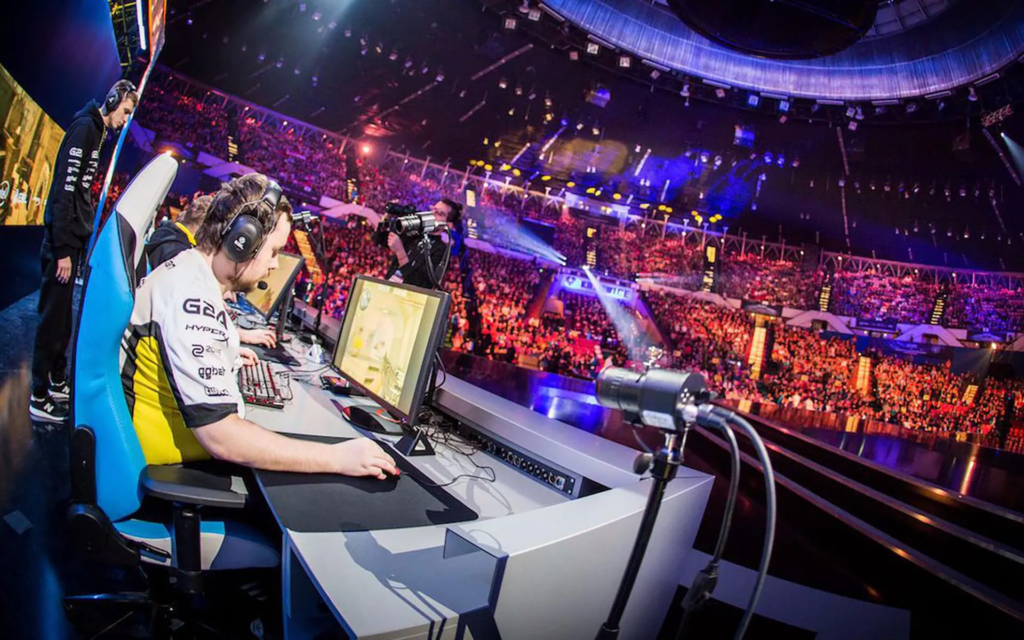The esports mainstream trend is growing faster than anyone expected. From small gaming communities to packed stadiums and global tournaments, esports has evolved into a billion-dollar industry. But is this rise sustainable? Or is esports simply riding a temporary wave of popularity?
Let’s take a closer look.
What’s Driving the Growth of esports mainstream?
Esports, or competitive video gaming, has moved from the fringes to the center of modern entertainment. Here are some key reasons why it’s gaining such momentum:
1. Huge Global Audience
Millions of people now watch esports events live. Competitions like the League of Legends World Championship and Dota 2’s The International draw audiences that rival traditional sports. Many fans tune in via platforms like Twitch and YouTube Gaming.
Esports content is available 24/7, and it’s often free to access. That kind of reach is something traditional sports can’t always offer.
2. Younger Generations Prefer Digital Sports
For Gen Z and Millennials, digital-first entertainment is the norm. Many prefer watching gamers play online over traditional TV programming. Esports aligns with how young people consume content: on-demand, interactive, and community-driven.
3. Low Entry Barriers
Unlike traditional sports, which often require expensive gear, training, or access to facilities, esports only needs a device and an internet connection. Anyone from anywhere can play, stream, or even build a career.
4. Big Money and Sponsorships
Top esports tournaments now offer prize pools in the millions. Players become celebrities with sponsorship deals, merchandise lines, and dedicated fanbases. Major brands like Coca-Cola, Red Bull, and even car manufacturers are investing heavily in the esports space.
5. Institutional Support
Universities offer scholarships for esports players. Professional teams have coaching staff, nutritionists, and mental health support. Governments in several countries now recognize esports as a legitimate sport.
Why Some People Think It’s Just a Fad
Despite the growth, not everyone believes esports is here to stay. Here are some reasons why critics remain skeptical.
1. It’s Still New
Esports doesn’t have the long history that traditional sports enjoy. Football and basketball have been around for over a century. Esports is still developing rules, structures, and professional systems. Some wonder if it will stand the test of time.
2. Limited Appeal to Older Generations
Esports has yet to fully cross into the mainstream for older audiences. Many people over 40 still don’t understand or value it. That gap could limit growth, especially in markets where family influence plays a role in entertainment and sports culture.
3. Risk of Burnout and Overwork
Top players often train for long hours with few breaks, leading to physical and mental health problems. Without strong player protections and industry standards, the esports scene risks pushing talent away.
4. Viewer Fatigue
As more games and tournaments launch, there’s a risk of oversaturation. If the market becomes flooded with too much content, fans may lose interest or shift to other platforms.

Signs That Esports Is Here to Stay
Still, several trends point to a bright future for esports. Let’s look at some indicators that it’s not just hype.
1. Integration With Traditional Sports
Many traditional sports teams are investing in esports. For example, football clubs in Europe have their own FIFA esports teams. This blend shows that esports is being taken seriously by long-established sports institutions.
2. Career Paths Are Expanding
Esports is not just about playing games. There are growing opportunities in broadcasting, marketing, game design, event management, coaching, and content creation. These career paths are drawing both students and professionals into the ecosystem.
3. Continued Innovation
Games and technology are constantly evolving. With developments in virtual reality, augmented reality, and AI, the esports experience will likely become even more immersive and interactive. This innovation keeps the format fresh and exciting.
4. Global and Inclusive
Esports is uniquely positioned as a global industry. Players from Asia, Europe, North America, and Latin America all compete on the same stage. Unlike many traditional sports, esports has fewer barriers for gender, nationality, or socioeconomic status.
5. Diverse Revenue Streams
The esports business model includes sponsorships, merchandise, ad revenue, in-game purchases, streaming income, ticket sales, and more. With such diversity, esports organizations are finding sustainable ways to grow.
Comparing Esports to Traditional Sports
Let’s look at how esports stacks up against traditional sports in some key areas:
Viewership
Esports has seen exponential growth in viewership, especially among younger audiences. Traditional sports still lead with older generations, but that gap is shrinking.
Accessibility
Esports is far more accessible. You don’t need a team, a coach, or expensive gear to get started.
Longevity
Traditional sports have decades of institutional support, while esports is still building. However, its rapid growth and investment suggest long-term potential.
Community Engagement
Esports thrives on social media and interactive platforms. Fans can chat live during matches, support players directly, and create their own content.
Challenges Ahead
For esports to continue growing, the industry needs to tackle several challenges:
- Ensuring player welfare and mental health support
- Preventing cheating, match-fixing, and other unethical behavior
- Building strong amateur systems and youth development programs
- Making sure women and underrepresented groups have equal access
- Creating long-term sponsorship and business models beyond short-term hype
Final Thoughts: Mainstream or Fad?
The esports mainstream trend shows all the signs of lasting success. It has global reach, loyal fans, financial investment, and strong cultural momentum.
But the industry must continue to evolve. Without structure, responsibility, and innovation, even the most exciting entertainment trends can fade. Fortunately, esports is doing many of the right things—expanding into education, innovating with technology, and building meaningful careers.
So is esports just a fad? All signs point to no. If current trends continue, it won’t just become mainstream—it might redefine what mainstream means in the digital age.
Do Follow USA Glory On Instagram
Read Next – Cracker Barrel Old Logo Return Wins Back Fans Fast






